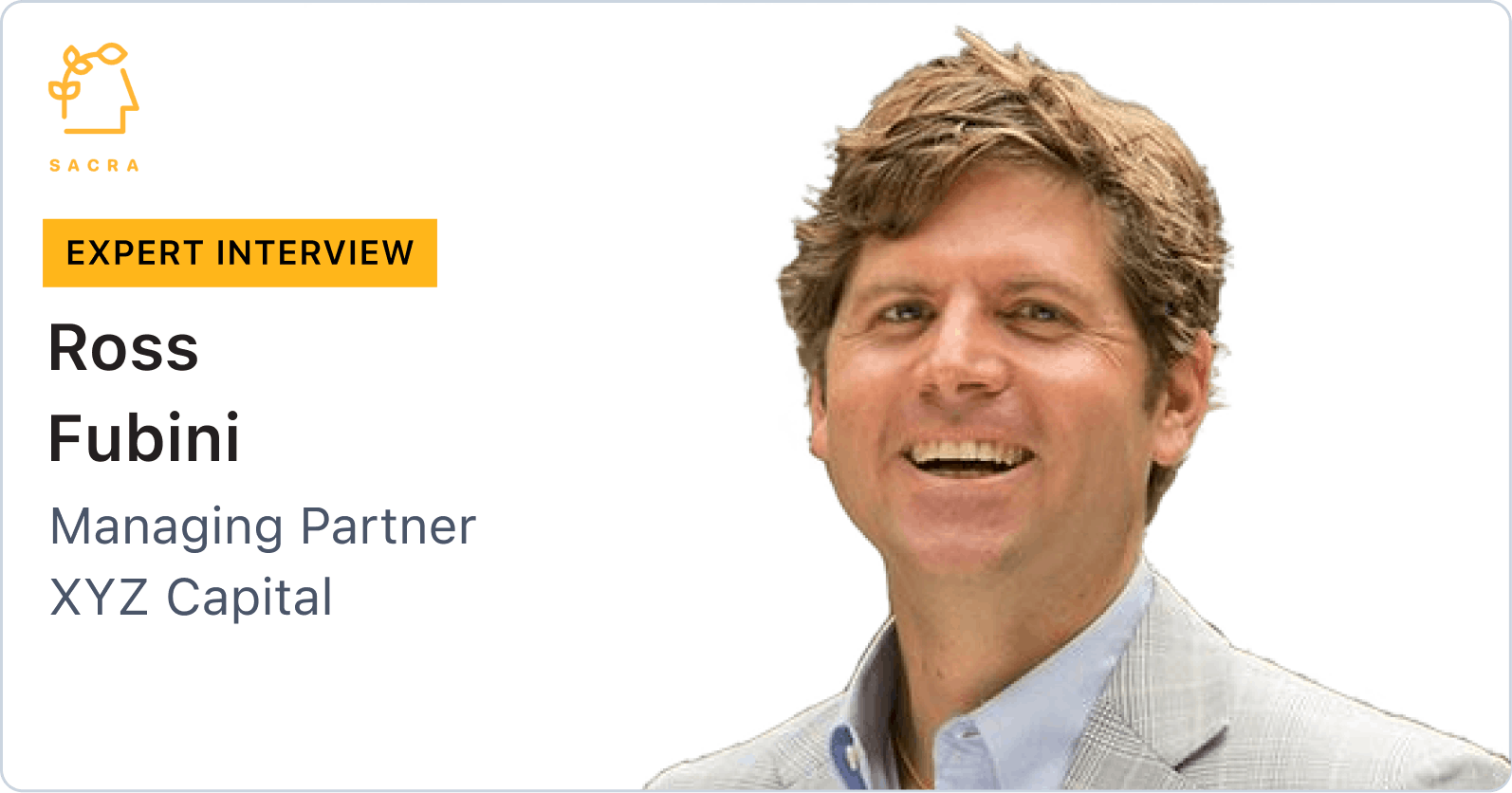Ross Fubini, Managing Partner at XYZ Capital, on the biggest opportunities in fintech today
 Jan-Erik Asplund
Jan-Erik Asplund

Background
Ross Fubini is Managing Partner at XYZ Capital. He is also a co-founder and Partner at Village Global. We talked to Ross to get his perspective on banking-as-a-service startups like Bond and Treasury Prime, API-first card issuers like Highnote and Lithic, FP&A companies like Mosaic and Pry, and creator economy tools like Stir.
Questions
- What's your larger thesis around FP&A startups? Why do you think this is an exciting place for founders to be building?
- FP&A tools like Mosaic and Pry are an application layer on top of bookkeeping, which puts them independent or makes them dependent on the infrastructure tools QuickBooks and Xero. How do you think about the positioning of Mosaic and other FP&A tools with respect to QuickBooks and Xero, and how do they think about partnering with them, competing with them, on FP&A and bookkeeping software?
- Where do you see the potential for wall-to-wall type businesses in finance, your “Figma” for finance?
- I'd love to hear your thesis around banking-as-a-service and how you think about the companies like Bond and Treasury Prime and what the opportunity is there.
- Do you think about card issuing as an alternative model to banking-as-a-service, or bucket them more separately?
- Why decide to build on Highnote versus a BaaS platform if both have this key proposition of going quickly?
- Do you think of the customer base of your average BaaS or card-issuing product as a venture portfolio?
- There’s an argument that it doesn’t really matter that 75% or 80% of Marqeta's revenue is from Cash App, because that's just a function of this venture dynamic, so that's in a way desirable or normal. I'd be curious to hear how you think about customer concentration as a risk in BaaS and card issuing.
- Are you seeing those kinds of big customers moving to these more modern models of card issuers?
- Are there any other areas of fintech that you’re particularly excited about?
- I'd love to hear you talk about Stir and why you think payments is particularly interesting as a wedge for creators.
- How do you think about empowering the “middle class” of the creator economy? What other big use cases jump out for those folks?
Interview
What's your larger thesis around FP&A startups? Why do you think this is an exciting place for founders to be building?
In general, the full toolkit and the job of the CFO has radically changed, particularly for mid to large-sized companies.
Historically, it was one of reporting, whether for the end of the quarter or for the end of a project.
Instead, the job of the CFO has become much more active, looking to be predictive about the quarter, predictive in planning, and much more agile rather than, say, fixing budgets for hiring. Today, they need budgets to change dynamically based on who's showing up where and at what salary ranges.
There's a huge opportunity to rebuild all the tools, from FP&A to accounting, to be more real-time, more designed around a technical audience, and more aware of all the larger cloud offerings where all this data is being stored, from Salesforce to Snowflake.
We've backed a company called Mosaic, which is why the leader right now is an FP&A for mid-sized Series B, C, and now D and beyond companies. So my money is where my mouth is—it's a really terrific place to be building companies and to be funding folks, every part of every role within the finance organization.
FP&A tools like Mosaic and Pry are an application layer on top of bookkeeping, which puts them independent or makes them dependent on the infrastructure tools QuickBooks and Xero. How do you think about the positioning of Mosaic and other FP&A tools with respect to QuickBooks and Xero, and how do they think about partnering with them, competing with them, on FP&A and bookkeeping software?
There are two things.
One, it is a source of additional information to whatever you have in Salesforce or in your CRM, so you get a more complete view of the customers and prospects.
Two, for HR, it gives you a complete view of spend, whether that's reported on a per-person basis or whether it’s showing up in your accounting systems.
I think it's most notable because QuickBooks and Xero are designed to structure data for accounting specifically, so that's about expense management. It's about data categorization.
The power of FP&A, again, and why it's been an exciting category for previous players and now for companies like Mosaic, is because you actually want to take all that data and present it in such a way that businesses can predict their revenue, predict their hiring, and really make use of that data.
If you are a particularly savvy investor, you might also be backing a new version of QuickBooks, a new version of Xero, or a new version of NetSuite, because there's an opportunity there to go change those systems so that they can be aware of the Stripes of the world, the Salesforces of the world, all the data that's coming into those systems and ultimately work more efficiently from an accounting point of view. But that's a whole different set of businesses.
Where do you see the potential for wall-to-wall type businesses in finance, your “Figma” for finance?
Basically everything for me is about first, what's the single-player mode—whether FP&A or supply chain procurement, whatever—and then what's the multiplayer mode.
The value of Figma is two-fold. One is you build workflows that sit across, say, a finance person and the other people they need to work with around hiring, around sales planning. The other value is the go-to-market value to the business and the ability to spread rapidly through a company because you're creating value for multiple parts of the business.
It's not just making the finance team more efficient and replacing one, two, three people in a divisional organization. You're helping the company truly plan out their revenue numbers, or make hiring plans, or so on.
The answer is I think it's exactly the right idea. It's the second line in the investment memo we wrote at the time that we backed the Mosaic team.
First off, it's still incredibly hard. For reference, Figma first had to build a vector graphics system in the browser that designers loved. That took a literal three or four years. That’s three to four years before you could then be excited about how easy it was to share stuff. Without that, it just wasn't that interesting. That's one part—it’s just truly a big build. Take it from someone that's been surprised about how hard it truly is.
The second thing, and this is the opportunity, is then to build those workflows. Right now, most companies manage their hiring plans inside spreadsheets because you can't do it in Workday. You certainly can't do it in Gusto. The opportunity is to build that into your FP&A modeling system. Everything from T&E to sales quarter expenditures to rationalizing, “Is the sales team good at predicting individual reps? Which groups are good or bad at that?”
That's a finance role working with sales. The opportunity is not just sharing information, like adding someone to the plan for the year, but really building workflows on top of that data once you own it.
That'll be really powerful once it happens for all the reasons I said around price, exposure, stickiness, all that kind of good stuff.
I'd love to hear your thesis around banking-as-a-service and how you think about the companies like Bond and Treasury Prime and what the opportunity is there.
It's changed over time, and I’ve been an investor in Bond since the very beginning.
My original thesis on banking-as-a-service platforms was very much like, “Fintech is going to be everywhere, but it’s really hard to do.” It's really hard to offer credit cards and checking accounts, and working with a bank is just difficult. Anyone that's tried to do that knows that. Making it easy to go do that work is the fundamental idea of all the banking-as-a-service platforms.
Candidly, we have different solutions that are being successful right now, but we can't yet tell what's the right model.
Since you brought up Treasury Prime, that's a really wonderful team. Readers will have to forgive me if I get this wrong, but Treasury Prime's history is selling next to banks. They would enable an SVB or another bank via the Treasury Prime API so that bank could be more modern in how they send wires or open accounts. But they're still fundamentally limited to what that bank wants to provide and what their infrastructure could provide.
Bond has the same notion of making it easier, but they're trying to really provide compliance and features and functionality so that you can run an offering at scale. With Bond, you can build a business that offers a small business checking account to every barbershop in the U.S. through their banking platform. That system's going to be compliant and able to work with a banking platform.
Until very recently, I was on the board of Beneficial State Bank, so I can tell you the lived experience. It's really hard to manage that banking relationship and manage it at scale, so that's what I think the opportunity looks like now.
One thing I'll tell you is going forward, there's a big opportunity in building this wide layer of compliance functionality that spans many banks. Right now you can get up and going with one solution quickly and scalably with Bond and others, but over time, it's like, "Can you give me the flexibility to move across banks?"
That’s going to be a really important idea, but we have yet to see that play out. I think things like that are coming.
Do you think about card issuing as an alternative model to banking-as-a-service, or bucket them more separately?
There’s definitely a separate opportunity to build a card issuing platform. We've invested in Highnote and Marqeta, obviously. Marqeta was modern several years ago, and so that was a big opportunity versus other solutions. Highnote and new challengers are offering basically purpose-built solutions for what enterprises are looking for now, which tends to be lower-level APIs. They want to see SKU-level data to introduce workflows into those low-level APIs for approvals and things like that and then be able to run across multiple kinds of rails.
It's not just, "Hey. Here's your credit card, but it’s expense-management aware." It’s about being able to integrate that card into other systems. Think about companies like AtoB that do fuel cards and want to run their own card systems on a modern issuer so they can wire those cards into other systems to drive decisioning and control.
This is part of the expansion of what happens when you want to build a modern closed-loop card. A closed-loop card is like a Starbucks card inside your mobile app. It has different economics, different risk profiles, and different usage profiles, and those are things you can now build on platforms like Highnote.
The ones that win here, in my view, are the ones that can do two things.
One, provide these very rich API sets and therefore, attract very large card programs over time. It's great to be enabling a new startup company, but it's more interesting if you’re enabling a new startup company and they become as big as Uber.
Two is that you can actually go run Uber's new card offering because you're a better solution. That's the opportunity right now.
The last thing I would say is that as a naïve venture person, when they were building Highnote, I used to harass the CEO going, "Who's your ideal customer?”
It turns out once Highnote launched, it was basically everyone that wanted to get live quickly. That just speaks to the amount of pull that's in the market and the amount of energy and enthusiasm, whether that’s people trying to do crypto on top of cards, or fuel cards, or just modern expense management solutions.
Why decide to build on Highnote versus a BaaS platform if both have this key proposition of going quickly?
It varies a lot around the functionality that you need. Highnote, for example, is like a full program manager to help run the entire card process. It really started with a whole general ledger so you could have each individual enterprise manage the complexities and the fund flows that were going through that, and most people aren't designed that way.
The Bond and the banking-as-a-service platforms do some of the same stuff, but they have different constraints because of the way that their bank partnerships run.
They do have these points of overlap, but they're also very different needs as viewed from specific customers. If you're trying to create a relationship like in the case of Squire where you want to I want to offer a business banking account and other services—well, that's where Bond is really differentiated in being able to get live quickly with a complete solution.
Do you think of the customer base of your average BaaS or card-issuing product as a venture portfolio?
You want to choose and enable high-quality, high-growth cards. You want to be in large, high-volume cards, period. That's how you make the business work.
You want to choose startups or mid-sized companies that are building really quality, novel products—novel fuel cards, novel expense management cards, and so on. You're trying to choose a bunch that can scale, and also, you want to make it possible for many of those folks to get started quickly so that then you can just rise up with them.
At the same time, you want to work with large card programs where you can have a differentiated feature set because you're a modern platform, and then move them over.
Certain providers are better at enterprise sales, and then others are better at helping people get started quickly. Those are different go-to-market motions, though I actually think you need to do some healthy amount of both to win at the end.
Checkr, for example—my understanding is that they had a huge amount of success just riding up Uber's growth curve. That's fine as long as you then diversify out. Twilio did that, and now they’re very widely diversified. You have to have a product that can add more customers in.
We'll see how—I'm not tracking this closely—Marqeta performs, because it has high customer concentration. There are some rumblings about that changing. Again, I'm not a public markets guy. Maybe that has changed, and I don't know anything really about it on the inside. The benefit, in theory, of a modern technology platform is you take all comers, and then you grow with many folks, some faster than others.
There’s an argument that it doesn’t really matter that 75% or 80% of Marqeta's revenue is from Cash App, because that's just a function of this venture dynamic, so that's in a way desirable or normal. I'd be curious to hear how you think about customer concentration as a risk in BaaS and card issuing.
To your comment, it's not a problem until it's the day it's a problem.
And Twilio is a great example here. Three years ago in its early days of going public, people talked about how much of its traffic was from Uber.
But companies like Facebook and a few other very large players acquired a much more diverse set of customers on their platforms because they had matured. In their case, you add other really significant products and expand the scope of the company. Every company ultimately has to do that, or frankly, they're down scored in the public markets because of that concentration risk.
That’s what I expect we'll see with a vast number of these platforms. The ability for them to get to a lot of large customers quickly, and especially moving historical, legacy customers or existing systems over these platforms, is something that will really matter a lot in terms of getting to a more diverse customer set.
Are you seeing those kinds of big customers moving to these more modern models of card issuers?
Yes. It's a slow transition because things are very sticky, but there's an immense amount of interest because they are reacting to their competition, who are sending their customers notifications when their card get swiped and doing other novel things.
Let’s say you swipe a card, and you told me this expense was a business expense. I can then tell you, based on what you told me about your taxes, that you actually just saved $3.20 when you bought your $6 latte because of your expected tax savings. There are some really clever ideas coming from challengers, and those little things like that are really compelling user experiences. If you can't do things like that, you're eventually going to lose your market to new players, and people are reacting to that across the board.
Financial services is actually the area where that's happened the fastest. Not everywhere. The fuel card guys are pretty slow to react currently, and we'll see if that changes. But if you look at the large banks and even some of the large financial providers, they're no dummies. They're moving pretty quick to modernize their systems, and they're not going to modernize on Fiserv or Marqeta. No shame to Marqeta, but they’re going to move to newer things as long as they're robust and trusted.
This is a classic startup picks-and-shovels approach. Do magical things for new companies. Grow with their success, and eventually, their competitors are going to need to come to you to do those same things.
Are there any other areas of fintech that you’re particularly excited about?
We've seen a bunch of companies recently, like three or four, that are all providing ledger systems. You’ve got your cards running, and your banking-as-a-service platform, and you need another independent ledger that tracks your customers' usage.
Another example is around payments. There's a lot still to do in payment flows, both for different verticals and for giving more payment features and flexibility. You can imagine something that enables payment plans and more approval workflows. There's a lot to do in the layer above the basics of the card issuing and the banking platforms, and I think that many of those solutions will show up verticalized and specialized to the needs of healthcare companies, to e-commerce companies, to consumer mobile apps. All coffee shops, for example, are eventually going to have the same financial products functionality that Starbucks has.
There are also whole other categories which end up being enabled. An easy one because it's crazy and visible is crypto. Where does crypto meet these environments in a regulated, smooth way? If I'm a consumer, and I have both U.S. dollars and crypto assets in my account, the way those interact for payments is totally different. That’s going to change for sure.
Another big one is letting people be global citizens. By that, I mean you can show up anywhere around the world, and you can get a U.S. based bank account, or you can transact how you want globally.
Lastly, there’s just bringing all this to B2B offerings. Broadly speaking, B2B solutions are trailing consumer solutions, but folks like Built are bringing this into the construction use case. Cedar is bringing payments into healthcare. There are lots of these big shifts going on, and mind you, there's a lot to build. They're all going to get accelerated by these platforms.
I'd love to hear you talk about Stir and why you think payments is particularly interesting as a wedge for creators.
Payments is interesting as a wedge for creators because it's how they get paid. Sitting in the money flow is always a very compelling place to be for any business and arguably any human.
Stir came together because I was looking to build financial products for creators. Joe, the CEO, got introduced to me by my friend Brian at Forerunner. He got introduced to me as a smart person who was thinking about the creator space.
Joe did an amazing job of spending time with creators, managers, and other people in the ecosystem, from editors to producers. He made this discovery that all these creators were essentially running small businesses, and they were hiring people, and paying people, and they were having to split the money that was coming to them from a brand deal or from YouTube across all these different folks. Splitting the money was an incredible pain in the butt, and not only that, they had to pay a fee—mostly through PayPal, and they had to pay it every time they interacted with anybody else.
That was happening because they were running on these rails that were not designed for business use cases and were not feature-rich to that point.
The insight there was that there was this whole category of creators that we all know are making tons of money out there in the world and that they just operate very differently. They get paid via brand deals, so revenue comes in very lumpy. It operates a little bit like the movies, where you might assemble a set of producers that are working with you, and if someone's not available, you maybe need to add another person or add someone that's going to do graphics and so on. All that work is very, very complex to do on the back-end.
What we found at Stir is that if you build a product that's really tailored for that use case, you see really strong adoption because people show up, and they know it's built for them. Then you're just scaling as creators scale and the number of platforms they want to be on scale.
Stir has ended up being a really exciting business. And that approach, focusing on starting with where the money is, is generally a very good rubric for doing customer discovery and product discovery.
How do you think about empowering the “middle class” of the creator economy? What other big use cases jump out for those folks?
I have two comments here.
One is that I think we're in the early days of this next iteration. There are more new platforms, with TikTok being obvious, where people are just making more and more money. You can see these striations.
My view, and I'm not intimate to these individuals but to the companies, is that some of the folks that you said, like MrBeast, are actually so big that they can solve problems with people. They're big enough, and the dollars are big enough, that they can throw bodies at them. There's a small number of people that are at that level.
Then, there’s a pretty big number—I don't know if it's folks above half-a-million followers, or above a certain revenue threshold—but those folks do not have tools that are designed for them. It'd be like if you had NetSuite, but you didn't have QuickBooks.
What are other things that that group needs? The biggest one is looking at products that will be adopted by a small number of large brands: say the most popular golfer or bodybuilder on YouTube. Pick a couple of the best of these categories. If you can build something for them that helps them make, let’s say, recurring revenue—that’s a very interesting thing that we spend a lot of time thinking about.
They're maybe going to make millions of dollars, and you're going to make hundreds of thousands. Then, can you make that into something that just goes down-market and gets ubiquitously adopted?
There are things like Linktree that do this. The scale is wide enough, and you can design the pricing wide enough, but it has to be designed in this ubiquitous way.
The second thing, and this is a little bit meta, would be if you can move all those people somewhere else—not to another platform, because I think that's so hard. As we've seen, I don't know if there's been a successful project like that besides OnlyFans. But you can get creators to go build on something like Cameo, something that’s a destination you would come to because of this different kind of value it offers.
An example of that would be Substack, where many creators are now. Another example here—again, this is bit of a leap—is enabling people to create NFTs.
My take is ultimately that you either make something that's helping a really wide set of people make more money, and more in the set of more lucrative, larger customers than in the smaller, or you're making something that takes all that energy from this wide set of creators and moves them over to another destination.
Disclaimers
This transcript is for information purposes only and does not constitute advice of any type or trade recommendation and should not form the basis of any investment decision. Sacra accepts no liability for the transcript or for any errors, omissions or inaccuracies in respect of it. The views of the experts expressed in the transcript are those of the experts and they are not endorsed by, nor do they represent the opinion of Sacra. Sacra reserves all copyright, intellectual property rights in the transcript. Any modification, copying, displaying, distributing, transmitting, publishing, licensing, creating derivative works from, or selling any transcript is strictly prohibited.




